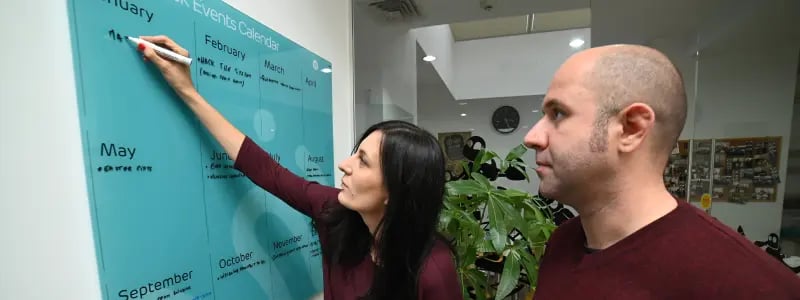How many times did you read or hear about companies bragging that they want to “do it right the first time”? Too many times, perhaps?
But “doing it right the first time” simply doesn’t work when it comes to building software products in 2023 and beyond.
Developing great software in a dynamic environment, where technology is constantly evolving, and users are demanding better experiences, requires building in iterations and always asking, “what can I do better next time?”.
So development teams need to experiment, learn and apply over and over again what they’ve discovered.
This thinking propelled the agile principles forward as a way of dealing with uncertainty and succeeding in an unpredictable environment.

The Sprint Retrospective is one of the Agile ceremonies in which teams gather to reflect on their process and find ways to do things better the next time.
Some people waver about the idea of retrospectives at the end of every sprint, and it’s easy to see why. It’s a meeting where teams talk about the good and the bad alike, so some ugly truths might emerge too.
Even so, at Wirtek we’ve been very loyal to this practice. It has tremendous benefits for our teams, project delivery, and clients.
Let’s explore some ideas to help you improve how you organize Agile Retrospectives and make the most out of them.
What are Sprint Retrospective meetings?
The 12th agile principle says, “At regular intervals, the team reflects on how to become more effective, then tunes and adjusts its behavior accordingly.”
A Sprint Retrospective is a meeting held by a software development team at the end of a Sprint to reflect on their way of working and how they can improve in the future.
The whole development team attends the Retrospective, and the Scrum master usually facilitates the meeting. The goal of the meeting is to identify improvement points and actions that will be implemented in the next iteration. This way, Sprint Retrospective meetings are an effective way to do short-cycled improvements.
According to the Scrum Guide by Ken Schwaber and Jeff Sutherland, the originators of Scrum, the purpose of the sprint retrospective is to:
- Inspect how the last Sprint went with regard to people, relationships, processes, and tools;
- Identify and order the major items that went well and potential improvements;
- Create a plan to improve the way the Scrum team does its work.
Sprint Retrospectives usually happen after the Sprint Review and before the next Sprint Planning. While the Sprint Review is an occasion for the development team to showcase the work they completed during the latest Sprint, the Retrospective represents an opportunity for honest feedback about what went well and what could be improved.
The cycle of the Scrum iteration
Benefits of Sprint Retrospective meetings
When done right, sprint retrospectives bring several benefits to the development team:
- A great opportunity to appreciate people’s contribution and increase their sense of purpose and belonging
- Increase team’s cohesion and independence; all actions coming out of retrospective are implemented by the team, making the process quicker and more efficient.
- It allows teams to discover what they can do better and take action in that direction, improving each Sprint. The outcome should always be an actionable list of the next steps.
- It strengthens the teams; retrospectives create a safe space to share honest feedback and for ideas to be heard.
- The development team can document wins and areas of opportunity.
What does a great Sprint Retrospective look like?
If you want to reap the full benefits promised by retrospectives, make time to prepare your meetings.
Here are a few tips for running successful Retrospective meetings from our experience at Wirtek:
- Ask people to come in prepared. Everyone should provide input and write that down before the meeting. This way, everyone contributes and has time to think about what really matters.
- Stay creative and switch techniques up. People can get bored fast, so adding new formats increases engagement and eliminates boredom, especially around holidays times or busier periods.
Two ideas that we experimented with at Wirtek are:
- comparing the sprint to a car model and explaining the choice
- thinking about what gift every team member would offer to the product they were developing.
We noticed both methods lift the mood and put people in a context where they want to share ideas and feedback.
- Focus on action items. The purpose of the meeting is to find ideas and ways in which the team can improve their way of working. Just talking about what could be done better but not transforming that into a task won’t move things forward. So you need to find concrete actions to help the team improve.
- Focus on what the team can actually do. While a lot of different ideas can emerge, it’s important that the facilitator keeps the conversation focused on what the team members can actually do themselves; otherwise, some actions might take too long to implement or not be implemented at all.
- Add some snacks or goodies; it’s not an easy meeting, and sometimes the discussion can turn into a not-so-pleasant one, so creating a relaxing atmosphere helps.
Sprint Retrospective Techniques to try out
Here at Wirtek the most popular formats we’ve been using are:
- “what went well, what could be improved”
- the 4L technique (like, loathed, lacked, learned)
.webp?width=777&height=291&name=sprint-retrospectives-2%20(1).webp)
What went well, what could be improved
Each team member writes down at least one or two ideas describing what went well during the last Sprint and what could be improved. The notes go on the board, and once everyone is finished adding notes, the team discusses each idea and extracts action items to implement during the next iteration.
The 4L technique - like, loathed, lacked, learned
Using the 4L technique, the facilitator asks the following questions:
- What did you like about the past Sprint?
- What did you loathe?
- What did you long for?
- What did you learn?
Start, stop, continue
The facilitator will ask the team what they would like to start doing in the next Sprint, what they would like to stop doing, and what to continue.
5 whys
This is a great exercise to try when there is something that didn’t go well, and you would like to avoid in the future. Start by asking why the failure happened. When you reach a conclusion, ask why that was the case. Keep asking “why” a few more times, and the cause of the problem will become obvious, and so the solution.
Dot voting
This is a great exercise to use when there are lots of improvement ideas coming out, and you need to prioritize them. Start by listing all action items on a whiteboard. Then ask each team member to vote for the top three ideas they would like to see at the top of the list by adding a dot. You can further discuss results by asking why one idea is more valuable than the rest and what would happen if the idea weren’t implemented.
Sprint Retrospective meetings are so much more engaging when the whole team is in the same room. But despite working remotely for the past few months, the teams in Wirtek have been doing their Retrospectives as usual. They replaced the whiteboard with an online board, but the value they get from these meetings stays the same.
Regardless of your preferred technique, remember to get everyone involved, focus on drawing actionable insights from the Retrospective, and keep experimenting with different formats to keep people engaged.



